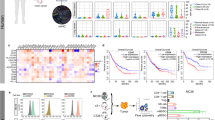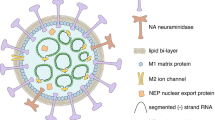Abstract
Replication-selective oncolytic adenoviruses hold promise, but novel mechanisms must be identified to maximize intratumoral virus persistence, spread and therapeutic transgene-carrying capacity while maintaining safety. One of the main approaches to engineering cancer-selectivity has been to delete a viral gene that is theoretically expendable in cancer cells. Results with this approach have been mixed, however, as evidenced by controversy over Onyx-015 (E1B-55kD(−)) selectivity. We hypothesized that the functional redundancy between viral gene products might limit selectivity and/or potency with this approach. Antiviral immune inducers of apoptosis (eg TNF-α) have not been thoroughly investigated in previous studies. We therefore explored whether deletion of functionally redundant viral genes, E1B-19kD and E3B, both independently antagonize TNF-α, could lead to enhanced oncolytic potency while maintaining selectivity. Since tumors have numerous blocks in apoptotic pathways, we hypothesized that deletion of one or both gene regions would result in cancer-selectivity in the presence of TNF-α. We have previously shown that the E1B-19kD deletion resulted in enhanced viral spread in vitro and in immunocompetent tumor models in vivo. In contrast, the impact of E3B deletion, especially its in vitro selectivity and potency, was not thoroughly characterized, although it resulted in rapid immune-mediated viral clearance in vivo. Furthermore, previous publications indicated that double-deleted mutants have selectivity but unsatisfactory efficacy. We compared the selectivity and potency of E1B-19kD(−), E3B(−) and E1B-19kD(−)/E3B(−) mutants to wild-type adenovirus. In cancer cells, the E1B-19kD(−) mutant had superior replication, spread and cytolysis (+) or (−) TNF-α; deletion of both E1B-19kD and E3B was relatively deleterious. In normal cells without TNF-α, similar results were obtained. In contrast, all three mutants were significantly inhibited in the presence of TNF-α. In immunocompetent mice, all three mutants were significantly inhibited in normal tissue. In tumors, only the E1B-19kD(−) mutant demonstrated enhanced replication, spread and antitumoral efficacy. Therefore, E1B-19kD deletion and E3B retention should be incorporated in oncolytic adenoviruses for enhanced safety and efficacy. In addition, functional redundant viral genes and their biological mediators/targets need to be carefully examined for the next generation of gene-deleted oncolytic viruses.
This is a preview of subscription content, access via your institution
Access options
Subscribe to this journal
Receive 12 print issues and online access
$259.00 per year
only $21.58 per issue
Buy this article
- Purchase on Springer Link
- Instant access to full article PDF
Prices may be subject to local taxes which are calculated during checkout







Similar content being viewed by others
References
Kirn D, Martuza RL, Zwiebel J . Replication-selective virotherapy for cancer: biological principles, risk management and future directions. Nat Med 2001; 7: 781–787.
Hawkins L, Lemoine N, Kirn D . Oncolytic virotherapy: a novel therapeutic platform. Lancet Oncol 2001; 3: 17–26.
Hermiston TW, Kuhn I . Armed therapeutic viruses: strategies and challenges to arming oncolytic viruses with therapeutic genes. Cancer Gene Ther 2002; 9: 1022–1035.
Heise C et al. ONYX-015, an E1B gene-attenuated adenovirus, causes tumor-specific cytolysis and antitumoral efficacy that can be augmented by standard chemotherapeutic agents. Nat Med 1997; 3: 639–645.
Jooss K, Chirmule N . Immunity to adenovirus and adeno-associated viral vectors: implications for gene therapy. Gene Therapy 2003; 10: 955–963.
Ries SJ et al. Loss of p14ARF in tumor cells facilitates replication of the adenovirus mutant dl1520 (ONYX-015). Nat Med 2000; 6: 1128–1133.
Bett AJ, Prevec L, Graham FL . Packaging capacity and stability of human adenovirus type 5 vectors. J Virol 1993; 67: 5911–5921.
Wold WS et al. Immune responses to adenoviruses: viral evasion mechanisms and their implications for the clinic. Curr Opin Immunol 1999; 11: 380–386.
Sung RS, Qin L, Bromberg JS . TNFalpha and IFNgamma induced by innate anti-adenoviral immune responses inhibit adenovirus-mediated transgene expression. Mol Ther 2001; 3: 757–767.
Burgert HG et al. Subversion of host defense mechanisms by adenoviruses. Curr Top Microbiol Immunol 2002; 269: 273–318.
Han J et al. The E1B 19K protein blocks apoptosis by interacting with and inhibiting the p53-inducible and death-promoting Bax protein. Genes Dev 1996; 10: 461–477.
Han J, Modha D, White E . Interaction of E1B 19K with Bax is required to block Bax-induced loss of mitochondrial membrane potential and apoptosis. Oncogene 1998; 17: 2993–3005.
Degenhardt K, Perez D, White E . Pathways used by adenovirus E1B 19 K to inhibit apoptosis. Symp Soc Exp Biol 2000; 52: 241–251.
Chinnadurai G . Control of apoptosis by human adenovirus genes. Semin Virol 1998; 8: 399–408.
Carlin CR et al. Epidermal growth factor receptor is down-regulated by a 10,400 MW protein encoded by the E3 region of adenovirus. Cell 1989; 57: 135–144.
Gooding LR et al. The 10,400- and 14,500-dalton proteins encoded by region E3 of adenovirus function together to protect many but not all mouse cell lines against lysis by tumor necrosis factor. J Virol 1991; 65: 4114–4123.
Steawart AR et al. The adenovirus E3 10.4K and 14.5K proteins, which function to prevent cytolysis by tumor necrosis factor and to down-regulate the epidermal growth factor receptor, are localized in the plasma membrane. J Virol 1995; 69: 172–181.
Gooding LR et al. The adenovirus E3-14.7K protein is a general inhibitor of tumor necrosis factor-mediated cytolysis. J Immunol 1990; 145: 3080–3086.
Ranheim TS et al. Characterization of mutants within the gene for the adenovirus E3 14.7-kilodalton protein which prevents cytolysis by tumor necrosis factor. J Virol 1993; 67: 2159–2167.
French LE, Tschopp J . Defective death receptor signaling as a cause of tumor immune escape. Semin Cancer Biol 2002; 12: 51–55.
Schulze-Bergkamen H, Krammer PH . Apoptosis in cancer – implications for therapy. Semin Oncol 2004; 31: 90–119.
Jaattela M . Multiple cell death pathways as regulators of tumour initiation and progression. Oncogene 2004; 23: 2746–2756.
Kirn D . Clinical research results with dl1520 (Onyx-015), a replication-selective adenovirus for the treatment of cancer: what have we learned? Gene Therapy 2001; 8: 89–98.
Kim J et al. Evaluation of E1B gene-attenuated replicating adenoviruses for cancer gene therapy. Cancer Gene Ther 2002; 9: 725–736.
Liu TC et al. An E1B-19 kDa gene deletion mutant adenovirus demonstrates tumor necrosis factor-enhanced cancer selectivity and enhanced oncolytic potency. Mol Ther 2004; 9: 786–803.
Bischoff JR et al. An adenovirus mutant that replicates selectively in p53-deficient human tumor cells. Science 1996; 274: 373–376.
Heise C et al. An adenovirus E1A mutant that demonstrates potent and selective antitumoral efficacy. Nat Med 2000; 6: 1134–1139.
Fueyo J et al. A mutant oncolytic adenovirus targeting the Rb pathway produces anti-glioma effect in vivo. Oncogene 2000; 19: 2–12.
Sauthoff H, Heitner S, Rom WN, Hay JG . Deletion of the adenoviral E1b-19kD gene enhances tumor cell killing of a replicating adenoviral vector. Hum Gene Ther 2000; 11: 379–388.
Harrison D et al. Wild-type adenovirus decreases tumor xenograft growth, but despite viral persistence complete tumor responses are rarely achieved – deletion of the viral E1b-19-kD gene increases the viral oncolytic effect. Hum Gene Ther 2001; 12: 1323–1332.
Hallden G et al. Novel immunocompetent murine tumor models for the assessment of replication-competent oncolytic adenovirus efficacy. Mol Ther 2003; 8: 412–424.
Duncan S et al. Infection of mouse liver by human adenovirus type 5. J Gen Virol 1978; 40: 45–61.
Nemunaitis J et al. Intravenous infusion of a replication-selective adenovirus (ONYX-015) in cancer patients: safety, feasibility and biological activity. Gene Therapy 2001; 8: 746–759.
Reid T et al. Hepatic arterial infusion of a replication-selective oncolytic adenovirus (dl1520): phase II viral, immunologic, and clinical endpoints. Cancer Res 2002; 62: 6070–6079.
Lieber A et al. The role of Kupffer cell activation and viral gene expression in early liver toxicity after infusion of recombinant adenovirus vectors. J Virol 1997; 71: 8798–8807.
Elkon KB et al. Tumor necrosis factor alpha plays a central role in immune-mediated clearance of adenoviral vectors. Proc Natl Acad Sci USA 1997; 94: 9814–9819.
Heise C et al. Intravenous administration of ONYX-015, a selectively-replicating adenovirus, induces antitumoral efficacy. Cancer Res 1999; 59: 2623–2628.
Wang Y et al. E3 gene manipulations affect oncolytic adenovirus activity in immunocompetent tumor models. Nat Biotechnol 2003; 21: 1328–1335.
Schmitz ML et al. The dual effect of adenovirus type 5 E1A 13S protein on NF-kappaB activation is antagonized by E1B 19K. Mol Cell Biol 1996; 16: 4052–4063.
Sparer TE et al. The role of human adenovirus early region 3 proteins (gp19K, 10.4K, 14.5K, and 14.7K) in a murine pneumonia model. J Virol 1996; 70: 2431–2439.
Kuprash DV et al. Redundancy in tumor necrosis factor (TNF) and lymphotoxin (LT) signaling in vivo: mice with inactivation of the entire TNF/LT locus versus single-knockout mice. Mol Cell Biol 2002; 22: 8626–8634.
Hayder H et al. Adenovirus-induced liver pathology is mediated through TNF receptors I and II but is independent of TNF or lymphotoxin. J Immunol 1999; 163: 1516–1520.
Jones N, Shenk T . Isolation of adenovirus type 5 host range deletion mutants defective for transformation of rat embryo cells. Cell 1979; 17: 683–689.
Pilder S, Logan J, Shenk T . Deletion of the gene encoding the adenovirus 5 early region 1b 21,000-molecular-weight polypeptide leads to degradation of viral and host cell DNA. J Virol 1984; 52: 664–671.
Subramanian T, Kuppuswamy M, Mak S, Chinnadurai G . Adenovirus cyt+ locus, which controls cell transformation and tumorigenicity, is an allele of lp+ locus, which codes for a 19-kilodalton tumor antigen. J Virol 1984; 52: 336–343.
Barker DD, Berk AJ . Adenovirus proteins from both E1B reading frames are required for transformation of rodent cells by viral infection and DNA transfection. Virology 1987; 156: 107–121.
Author information
Authors and Affiliations
Rights and permissions
About this article
Cite this article
Liu, TC., Wang, Y., Hallden, G. et al. Functional interactions of antiapoptotic proteins and tumor necrosis factor in the context of a replication-competent adenovirus. Gene Ther 12, 1333–1346 (2005). https://doi.org/10.1038/sj.gt.3302555
Received:
Accepted:
Published:
Issue Date:
DOI: https://doi.org/10.1038/sj.gt.3302555
Keywords
This article is cited by
-
Oncolytic virotherapy in veterinary medicine: current status and future prospects for canine patients
Journal of Translational Medicine (2012)
-
The oncolytic adenovirus AdΔΔ enhances selective cancer cell killing in combination with DNA-damaging drugs in pancreatic cancer models
Gene Therapy (2011)
-
Comparison of the E3 and L3 regions for arming oncolytic adenoviruses to achieve a high level of tumor-specific transgene expression
Cancer Gene Therapy (2008)
-
A phase I trial of intravenous infusion of ONYX-015 and enbrel in solid tumor patients
Cancer Gene Therapy (2007)
-
Common effector processing mediates cell-specific responses to stimuli
Nature (2007)



